Upstox Originals
Are energy stocks powering up?

5 min read | Updated on July 07, 2025, 12:34 IST
SUMMARY
2025 has thrown many surprises for investors, major among them has been the swings in crude oil prices. As global disruptions settle, charts reveal an underlying controlled downtrend in oil prices. In this article, we explore this trend in greater detail and further look at implications for allied stocks and sectors.
Stock list

A technical examination of oil prices reveals that it has been in a defined falling channel since July 2023.
Crude oil prices are determined by a complex interplay of supply-side and demand-side factors, including OPEC production decisions, geopolitical tensions, global economic growth, exchange rates, and shifts in energy demand.
For instance, the June 2025 flare-up between Israel and Iran triggered an ~10% overnight surge in Brent crude, as markets feared disruptions to flows through the Strait of Hormuz.
However, as the escalation remained localised and no major pipelines were impacted, prices stabilised over the following days and subsequently returned to pre-spike levels.
This pattern highlights how oil markets frequently react sharply to geopolitical shocks, yet adjust swiftly when underlying supply fundamentals remain stable.
Technical structure of crude oil: Persistent downtrend within defined range
A technical examination of the weekly chart reveals that crude oil has remained in a defined falling channel since July 2023. Over the past 24 months, it has consistently followed a declining trajectory, respecting the boundaries of this downward-sloping channel.
The recent 10% price spike, triggered by geopolitical tensions, failed to produce any structural change; instead, the upward movement found resistance precisely at the upper trendline of the channel, reaffirming the strength of the technical boundary.
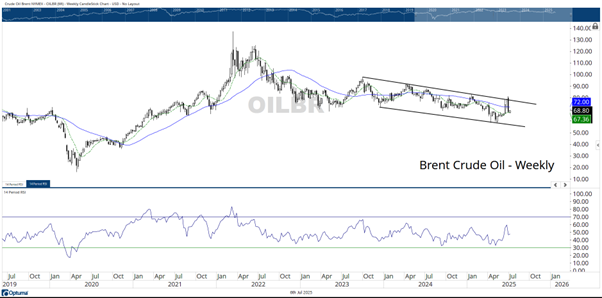
The interaction of moving averages further reinforces the prevailing weakness in crude prices. Historically, crossovers of the 10-week and 40-week moving averages have provided meaningful directional cues.
At present, the 10-week moving average is positioned below the 40-week moving average, reflecting a bearish undertone. These averages are currently placed at $67.36 and $72, respectively, further indicating that the recent bounce has not altered the medium-term trend.
Looking ahead, the likelihood of any major directional move appears limited. On the upside, the zone near $78 acts as a significant resistance level, and crude oil is expected to remain within the broad confines of the falling channel unless this level is decisively breached.
On the downside, strong support is identified at $57 and $55. While a weaker U.S. Dollar may offer some support to crude prices, the overall structure suggests a continuation of range-bound, oscillatory behavior unless disrupted by any major global event.
Implications of stable crude prices on Indian equities
Stable crude oil prices provide a degree of predictability that benefits several segments of the Indian equity market. For oil marketing companies (OMCs) such as Indian Oil Corporation (IOC), Bharat Petroleum (BPCL), and Hindustan Petroleum (HINDPETRO), price stability aids in maintaining refining margins and reduces under-recovery risks, thereby supporting profitability.
For upstream exploration companies, however, such as ONGC, stable or lower prices may cap revenue growth, as their earnings are directly tied to crude price realisations.
Reliance Industries, with its integrated business model spanning refining, petrochemicals, and retail, is relatively resilient; stable prices help optimize input costs and improve planning for downstream operations. GAIL, engaged in natural gas transmission and marketing, benefits when input price volatility is low, as it supports stable transmission margins and demand visibility. Overall, stable oil prices provide a supportive environment for downstream companies while limiting the earnings upside for upstream players.
Emerging opportunities in O&G stocks
The Nifty Oil & Gas Index has confirmed a trend reversal, backed by a strong bullish divergence between the RSI and price in the first quarter of this year. Following a steady uptrend from its lows, the index has recently broken out of a consolidation phase, signalling renewed strength.
A bullish golden crossover—where the 50-day moving average crossed above the 200-day moving average—further reinforces the positive momentum. Against this constructive technical backdrop, several individual stocks within the index now present compelling breakout and trend-following opportunities.
RELIANCE: The stock confirmed a trend reversal after crossing above the ₹1,350 level in April this year. It now trades firmly above all key moving averages, reinforcing its upward bias.
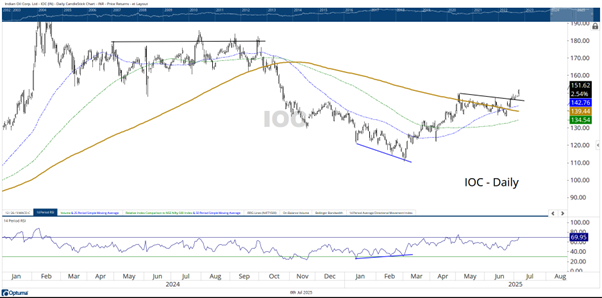
IOC: After forming a base between January and March, accompanied by a bullish RSI divergence, IOC reversed its trend and moved above key moving averages. During its consolidation phase, a golden crossover occurred, with the 50-DMA crossing above the 200-DMA.
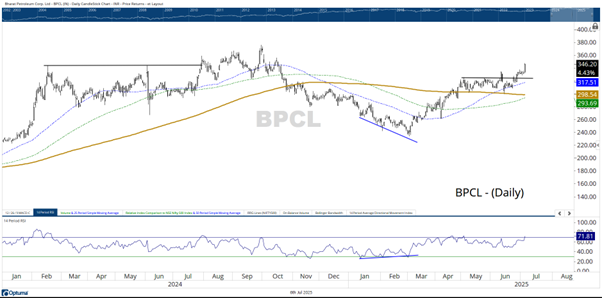
BPCL: The stock ended its prolonged downtrend by forming a base in Q1 of this year. It has since been trending higher, forming a series of higher lows. A fresh breakout has followed recent consolidation, and a golden crossover emerged last month.
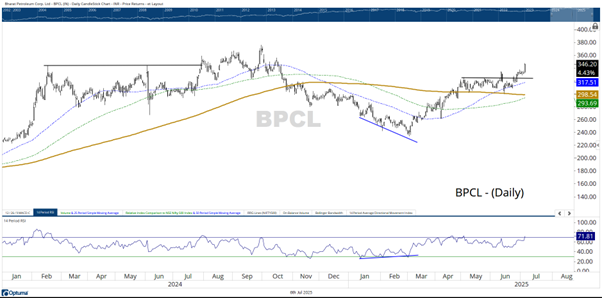
HINDPETRO: Following a phase of relative underperformance, the stock has broken out above a significant multi-point resistance near ₹420. A golden crossover also occurred during this recent consolidation.
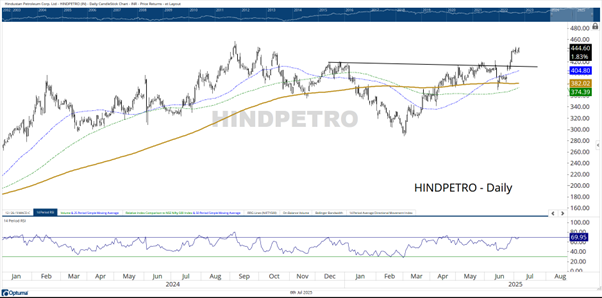
GAIL: After a sustained uptrend from September to March, GAIL is now attempting a trend reversal. A breakout appears imminent. While the price consolidates, the OBV has positively diverged and marked a new high, signaling strong accumulation.
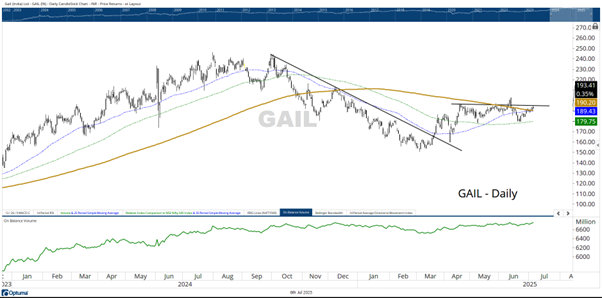
Parting thought
In conclusion, the selected oil and gas stocks have witnessed a notable price run-up over the past several sessions, making them susceptible to short-term consolidation within a defined range. However, the underlying technical structure across these names points toward a sustained and broad-based uptrend in the weeks ahead.
These stocks could merit consideration for accumulation on small declines, given their improving momentum and strong chart setups. With the broader markets currently undergoing sectoral rotation, the O&G and Energy space is well-positioned to emerge as a key leadership group in the near to medium term, supported by favorable technical signals and improving relative strength across the sector.
By signing up you agree to Upstox’s Terms & Conditions
About The Author
Next Story
